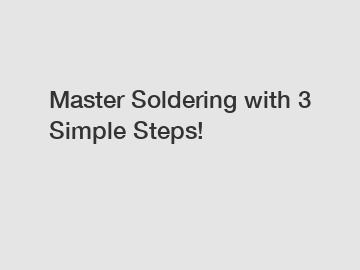Master Soldering with 3 Simple Steps!
Soldering may seem like a daunting task for those who are new to electronics or DIY projects, but with the right knowledge and practice, it can be a simple and rewarding skill to master. Whether you're building a circuit board, repairing a broken wire, or creating your own custom electronics, soldering is an essential technique that can help you achieve professional-quality results.
In this blog post, we'll break down the process of soldering into three simple steps that anyone can follow, regardless of their level of experience. With a little bit of practice and the right tools, you'll be on your way to becoming a master solderer in no time.
Step 1: Prepare Your Materials.

Before you begin soldering, it's important to gather all of the necessary materials and tools. This includes a soldering iron, solder wire, flux, a soldering stand, and any components or wires that you'll be soldering together. Make sure that your soldering iron is clean and in good working condition, and that you have a well-ventilated workspace to prevent any fumes from accumulating.
Next, prepare the surfaces that you'll be soldering by cleaning them with a small amount of flux. Flux helps to remove any oxidation or contaminants from the surfaces, allowing the solder to flow more easily and create a strong bond. Additionally, make sure that the components are properly aligned and secured in place before you begin soldering.
Step 2: Heat and Solder.
Once everything is prepared, it's time to heat up your soldering iron and begin the soldering process. Start by melting a small amount of solder onto the tip of the soldering iron to help transfer heat to the components more efficiently. Then, touch the tip of the soldering iron to the joint that you'll be soldering and wait for the components to heat up.
As the components heat up, gently touch the solder wire to the joint and allow it to flow evenly between the two surfaces. Be careful not to apply too much solder, as this can create a messy joint that may not be secure. Instead, aim for a smooth and shiny appearance that indicates a strong bond between the components.
Once the joint is fully soldered, remove the soldering iron and allow the solder to cool and harden before moving on to the next joint. Repeat this process for each connection that you need to solder, taking care to ensure that each joint is clean, secure, and free of any excess solder or flux.
Step 3: Inspect and Test.
After you've finished soldering all of your joints, it's important to inspect each connection to ensure that it is properly soldered and free of any defects. Look for signs of cold joints, which can appear dull or grainy, as well as any bridges or shorts that may have formed between adjacent connections. If you discover any issues, reheat the joint and add more solder as needed to correct the problem.
Once you've inspected all of your connections, it's time to test the circuit or device to ensure that everything is working properly. Use a multimeter or other testing equipment to check for continuity, resistance, or other electrical characteristics that may indicate a problem. If everything checks out, congratulations – you've successfully soldered your components together!
Mastering the art of soldering takes time and practice, but by following these three simple steps, you can quickly improve your skills and become a proficient solderer. Remember to take your time, be patient, and practice regularly to build confidence and proficiency in this essential technique. With a little bit of dedication and the right tools, you'll be well on your way to becoming a master solderer in no time. Happy soldering!
If you want to learn more, please visit our website low price desktop dispensing robot, desktop soldering robot, Glue Dispenser Machine.

Comments